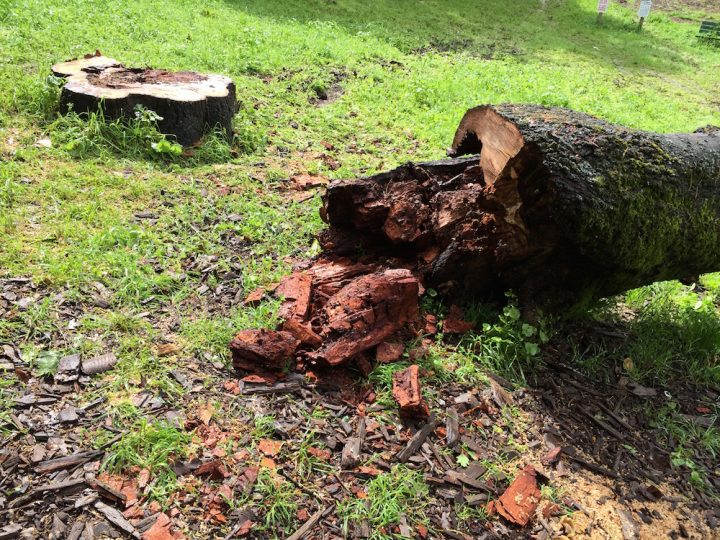If a tree falls in a forest and no one is around to hear it, does it make a sound? Yes, especially, when it falls into a power line. It makes a kind of alarming “zzzapp!” sound. And it happened around 6 PM yesterday evening according to a user of the neighborhood alert app “Nextdoor,” who notified residents of Petaluma’s Oak Hill-Brewster neighborhood that a tree in Oak Hill Park had fallen into live power lines.
A city crew has since cleaned it up but the event has been par for the course for arborists like Paul Dubois of Santa Rosa’s Davey Tree. Dubois has spent much of the last week responding to calls of fallen trees and other arboreal ailments. The fact that the El Nino storm system is presently wreaking havoc with local trees is ironic since the state of California has dedicated March 7 to 14 as Arbor Week.
As El Nino brings heavy rains, the accompanying high winds mudslides and storms are expected to cause issues for local trees. Stress from the ongoing drought (don’t let the rain fool you – it’s still happening) has already weakened trees and killed more than 22 million trees in California thus far.
So, basically, “Screaming Trees” isn’t just a 90s alt-rock band – it’s what trees are apparently doing all over Petaluma. You just have to know how to listen. Here’s how:
1. Root and Soil Failure
“Because they’ve been weakened by so many years of drought, the root systems are weak. There is a lot of dead wood in trees so we’re gonna have limb failures. Since we have so much rain, even healthy trees, are threatened because too because you’re starting to see soil failure, because the soil’s just so saturated,” says Dubois, who adds that ultimately all the rain is a good thing. “But as far as the long-term health for them, it’s great. It’s awesome. ”
2. Conks & Turkey Tails
Fungus, a.k.a brown or white rot, is often a symptom of a larger problem, Dubois explains. “We call them ‘conks’ or ‘turkey tails,’ they’re mushrooms at the bottom or the base of the tree that are a sign of weak root system,” says Dubois. “There eating up trees and roots and, and it, it shows itself by this ‘conk’ or mushroom at the base of the tree. That’s one of the things we look for.”
3. Cavities and Previous Injuries
Ditto cavities and indications of previous limb failures whether by neglect or natural processes. Preventative care is one way to head off issues. Dubois recommends having an International Association of Arboriculture certified arborist inspect your trees and says most reputable companies will evaluate your trees for deadwood, relative health of the canopy, and the need for weight reduction pruning, free of charge.
Though accidents from falling limbs or whole trees are relatively rare, says Dubois, homeowners should still be vigilant. “One of the reason it’s rare is because we’re not outside underneath trees during storms like this. You don’t want to be out,” Dubois deadpans. “I wouldn’t want to stand underneath an oak tree on a day like this.”
With this much rain, however, even healthy trees can start falling. That said, don’t fret too much if your tree loses a branch.
“One thing you really need to know is that trees naturally lose limbs, that’s what they do,” says Dubois. “, These things are self-pruning so it is, it is both a natural process and just a part of the lifecycle for them.” He adds, “To live around trees, you accept a small degree of risk.”
Daedalus Howell is the author of Quantum Deadline, a darkly comic sci-fi crime novel, set in Lumaville. Also, you’ll never believe the strange goings-on at DaedalusHowell.com.



